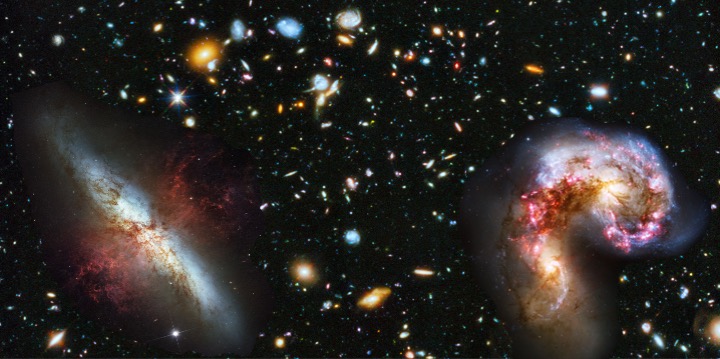Special Session SS7
29 June 2022
The Interstellar Medium of Infrared Galaxies, from the Present to Cosmic Noon

News:
In addition to the two review talks provided by the invited speakers, this special session anticipates awarding up to 15 contributed talks. Also, up to 15 e-posters will be scheduled as flash-talks. Note that for this year's EAS annual meeting all talks (review, contributed and flash) will be given in person and that there will be no on-line access to Symposia or Special Sessions. Thus, registration and physical presence are mandatory to be able to present and/or attend talks.
Aims and scope
Our understanding of the cosmos has been revolutionized during the past two decades by the discovery that a large fraction of the star formation occurring in the Universe during its peak of activity, z ~ 1-2, took place within dust-obscured galaxies. In fact, half of the stars we see today have been formed within star-forming systems enshrouded by copious amounts of gas and dust, making them shine in the infrared (IR). As such, the study of these infrared-luminous galaxies all the way from their first emergence in the early Universe until the present day offers unique insights into the star formation, metal enrichment, stellar mass growth and quenching mechanisms that drive galaxy evolution.
In recent years, high angular resolution observations from IR and (sub-)mm facilities like ALMA, JVLA or NOEMA, are providing us with an extraordinarily detailed multi-scale and multi-phase view of the interstellar medium (ISM) of dusty, IR-luminous galaxies at various comic epochs. However, a large number of questions still remain unanswered: What is the role of gas and dust in the overall decrease of the star formation activity in galaxies from cosmic noon to the present day? What are the mechanisms responsible for the stellar mass build-up and the ultimate quenching of star formation? Are active galactic nuclei (AGN) essential for the regulation of galaxy growth? Are galaxy mergers a catalyst of evolution? What is the role of the environment in the transformation of the average ISM properties as a function of redshift? What is the nature of the optically dark, yet IR-luminous sources recently discovered by ALMA? Are massive gas clumps and star-forming complexes ubiquitous in IR galaxies? If so, how much do their physical properties differ between the near and far Universe? How will JWST improve our understanding of the processes that shape the ISM in IR galaxies?
Whether they are powered by star formation or AGN, these extraordinary systems are excellent laboratories to investigate the complex interplay between the gas, dust and stars, allowing us to study the processes that regulate the life-cycle of galaxies across cosmic time. We aim to bring together experts in the study of the evolution of galaxies and their interstellar medium over the last ~11 billion years to share new results and insights regarding the nature and physics of IR galaxies.
Programme
- Gas Content and ISM properties
- Kinematics and Outflows
- Resolved Structures and Environment
Invited speakers
- Nearby Universe: Amelie Saintonge (University College London, UK)
- Cosmic Noon: Francesco Valentino (Cosmic DAWN Center / KU, Denmark)
Scientific organisers
Tanio Diaz Santos (co-chair; IA-FORTH, Greece)
Georgios Magdis (co-chair; Cosmic DAWN Center / DTU-KU, Denmark)
Giulia Rodighiero (co-chair; University of Padova, Italy)
Chiara Feruglio (INAF, Italy)
Jacqueline Hodge (Leiden Observatory, The Netherlands)
Miguel Pereira Santaella (CAB-CSIC, Spain)
Alexandra Pope (UMass, USA)
Eva Schinnerer (MPIA, Germany)
Contact
tanio @ ia.forth.gr
giulia.rodighiero @ unipd.it
georgios.magdis @ nbi.ku.dk
Updated on Thu Feb 03 16:55:41 CET 2022
|

 A power cut will shut down all EAS services on Tuesday, 10 January 2017 starting at 7:30 CET.
A power cut will shut down all EAS services on Tuesday, 10 January 2017 starting at 7:30 CET.


